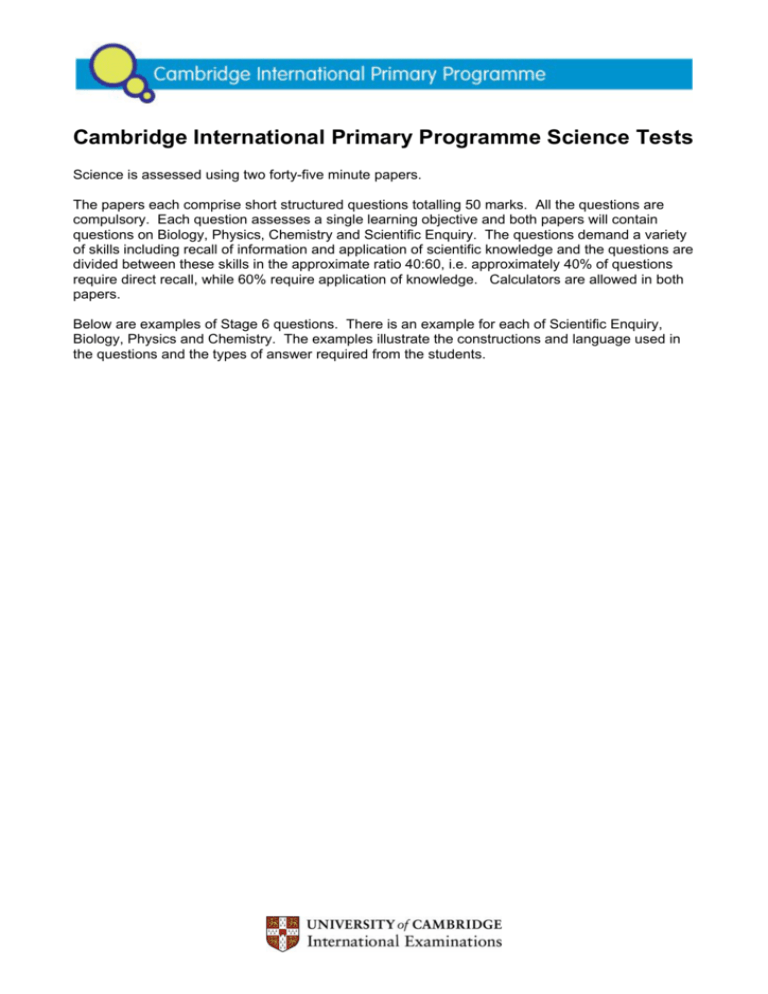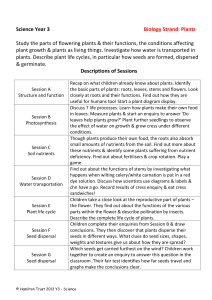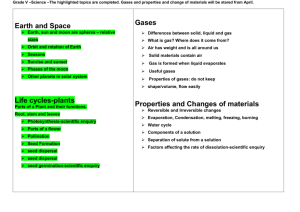Cambridge International Primary Programme Science Tests
advertisement

Cambridge International Primary Programme Science Tests Science is assessed using two forty-five minute papers. The papers each comprise short structured questions totalling 50 marks. All the questions are compulsory. Each question assesses a single learning objective and both papers will contain questions on Biology, Physics, Chemistry and Scientific Enquiry. The questions demand a variety of skills including recall of information and application of scientific knowledge and the questions are divided between these skills in the approximate ratio 40:60, i.e. approximately 40% of questions require direct recall, while 60% require application of knowledge. Calculators are allowed in both papers. Below are examples of Stage 6 questions. There is an example for each of Scientific Enquiry, Biology, Physics and Chemistry. The examples illustrate the constructions and language used in the questions and the types of answer required from the students. Scientific Enquiry 1 Some seeds are spread by the wind. A group of students carry out the experiment below to find out about the distance that seeds travel if they are dropped from different heights in front of a small fan. ruler Seed dropped here. Height above ground Seed blown by the wind from the fan small fan wind Seed lands here. Distance travelled tape measure Here are their results. Distance travelled by seed in cm Height above ground in cm 1 2 3 5 7 12 11 10 24 19 17 15 27 29 34 20 41 43 36 25 49 54 47 (a) Describe how the height above the ground that the seed is dropped from affects the distance that it travels. [2] (b) Why did the children repeat each experiment three times? [1] (c) David plots a line graph to show the results. 60 50 40 y axis 30 20 10 5 10 15 20 25 30 x axis He has forgotten to label the graph axes. What should the label be on the x axis? [1] (d) Use the graph to predict what the average result would be if the seed was dropped from 30 cm. Give the unit. [1] Biology 2 Here is a picture of a plant. A B (a) Name part A [1] (b) Name part B [1] (c) Roots are needed to hold the plant firmly in the ground. Give one other reason why roots are important to a plant. [1] Physics 3 At a concert there is a spotlight on a singer. spotlight A singer audience (a) Draw two arrows to show how the audience can see the light shining on the singer. [2] (b) There is a shadow of the singer behind her. Explain how the shadow is formed. [1] Chemistry 4 Solids liquids and gases have different properties. The table below shows some of these properties. Complete the table by putting ticks in the correct boxes. Some rows will need more than one tick. The first one has been done for you. Property Can be easily squashed into a smaller volume solid liquid Gas 9 Flows through pipes and has a fixed volume Has a fixed volume and fixed shape Takes the shape of the container into which it is put Spreads out over a surface if put on the surface Usually cannot be seen [5]







